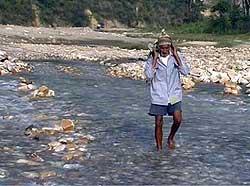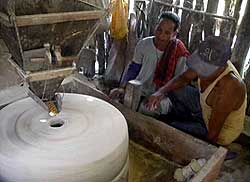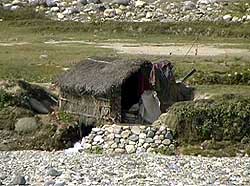 Two years ago, when flashfloods devastated his fields near Hetauda, Ram Sharma thought he had lost all. The 60-year-old farmer had no food, no land and no hope of supporting his wife, sons and grandchildren.
Two years ago, when flashfloods devastated his fields near Hetauda, Ram Sharma thought he had lost all. The 60-year-old farmer had no food, no land and no hope of supporting his wife, sons and grandchildren.
Suddenly, Ram hit upon an idea: why not use the same water that destroyed his farm to set up a ghatta waterwheel to grind maize and produce flour? All he needed was a tree trunk for the runner, some timber to craft the turbine wheel, a stone grinder and a convenient stream. Soon, his water mill was ready and villagers found it easier to grind their corn and wheat nearby instead of travelling miles to reach a diesel mill in town. His business boomed and today Ram makes Rs 2,000 a month from his ghatta. Says the ever-cheerful farmer: "Good thing I had the idea when I did, and there was this traditional knowledge that was passed down from our ancestors."
Across Nepal, this simple but effective water-powered technology is being rapidly replaced by diesel and electric mills. Wherever roads have reached remote areas, traditional ghatta owners have lost their jobs to the march of time. But as Ram Sharma's experience shows, small is still beautiful. The ghatta is still the simplest, cheapest and most convenient way for farmers to earn a living.
"The start-up investment is very small and the technology is indigenous," says Nakul Debkota, a student of the nearby Basamari village. "If there is money for motor-driven mills, there is no reason why we should not revive ghattas." Fellow-student, Sunil Lamichhane agrees: "This ancient tradition has not just survived in modern times, but it is still useful and provides a living."  You would expect young college students like Nakul and Sunil to be infatuated with modern technology, but they seem to think it is their community's duty to preserve ghattas. "Just because we are in a hurry to keep up with these fast times, there is no reason to abandon what our ancestors left us. If we don't preserve what we have, future generations will see ghattas only on television," says college student Dhruba Debkota. They are not saying this for effect, the students seem to genuinely believe what they say.
You would expect young college students like Nakul and Sunil to be infatuated with modern technology, but they seem to think it is their community's duty to preserve ghattas. "Just because we are in a hurry to keep up with these fast times, there is no reason to abandon what our ancestors left us. If we don't preserve what we have, future generations will see ghattas only on television," says college student Dhruba Debkota. They are not saying this for effect, the students seem to genuinely believe what they say.
There are four ghattas in Basamari, all of them do a good trade. Competition has improved services and brought prices down for ordinary villagers. Despite having their ghattas washed away by the Rapti during the monsoon, the owners rebuild them annually. Demand for flour is high and the owners make a regular income. We saw school children carry sacks of maize to the mills before school. The flour is ready to take home in the evenings.
Water mills often raise the problem of sharing water between mill owners and farmers but at Basamari the villagers managed to sort their disputes amicably. The ghattas are allowed to channel water since, the farmers reasoned, the mills don't actually expend the resource as much as use its energy. "We also managed to convince the villagers that ghattas wouldn't affect farming as long as we make them upstream from their farms," says ghatta-owner Hari Sharan Karki.
Creeping urbanisation from nearby Hetauda and the proliferation of diesel and electric mills has meant that many busy villagers are going to town take their grain to town. "People are busy on the farm or in the office and don't have the patience to wait so they choose to take their grain to electric mills," says Rajesh Upreti, owner of an electric mill. Although charges for the traditional ghattas are cheap, they are time consuming. What takes an electric mill a few hours is often a full days work on the old water mills.  In time, villages like Basamari could become like Handhikhola where ghattas are being replaced by the offerings of urbanisations. But all is not lost. Traditional ghattas can now be made more efficient by upgrading the turbines. One of the organisations specialising in ghattas is the Centre for Rural Technology (CRT) that has designed ghattas with Improved Water Mill technology. The main upgrade is changing the traditional wooden runner with a hydraulically-designed penstock pipe and replacing the wooden paddles with cup shaped blades. This increases its operational efficiency and makes it useful with additional tasks like hulling, electricity generation and oil-expelling.
In time, villages like Basamari could become like Handhikhola where ghattas are being replaced by the offerings of urbanisations. But all is not lost. Traditional ghattas can now be made more efficient by upgrading the turbines. One of the organisations specialising in ghattas is the Centre for Rural Technology (CRT) that has designed ghattas with Improved Water Mill technology. The main upgrade is changing the traditional wooden runner with a hydraulically-designed penstock pipe and replacing the wooden paddles with cup shaped blades. This increases its operational efficiency and makes it useful with additional tasks like hulling, electricity generation and oil-expelling.
Dil Maya Tamang has been running her ghatta for the past 18 years and is the only one with an improved water mill in Basamari. For the last two years her income has improved and the efficiency of her mill has more than doubled. "I used to grind only three pathis in one day. Now I can finish seven pathis," says Dil Maya, who is helping other women try out the new mill. "I'm not greedy, I want other women to benefit and become more independent too.".
But for Ram Sharma, even an old ghatta is still good enough. Despite his age, he walks for hours with a 50kg sack of flour on his back to sell at Hetauda for a Rs 50 profit . "I wish the sahus paid me more, but at least there is some cash," he says.
Shop owner, Kedar Shrestha is a regular buyer and is very impressed with the quality of flour from traditional mills. "Make sure you bring more and early in the morning," Kedar tells Ram. His customers all prefer ghatta flour, "It's clean and keeps better."
Upgrading the old
The improved water mill is an upgraded version of a traditional water mill (TWM) that converts hydro-power from water into mechanical power. The two upgraded versions are the improved ghatta (IG) and Multi Purpose Power Unit (MPPU). The mechanical power generated by the IG and MPPU is used mainly to process local agricultural produce, generate micro-level electricity and pump water. Twenty kilograms of cereals like maize, wheat and millet are ground in an hour by a IWM and 65-90kg per hour with a MPPU compared to just 15kg in a TWM. The power output can range from 2 to 5 kilowatts and machines like a rice huller, oil expeller and dynamo can be fitted easily. The small-scale cottage industry can run a wood saw, planer and looms.
In upgraded mills, metals replace all wooden parts like paddles, shaft, chute or penstock pipe and the hopper. A wooden vibrator is replaced with a metal-gated regulator. The grinding stones are replaced with artificial cast-stones. These improvements make the water wheels last longer.
A traditional water mill can be upgraded to the improved ghatta by two workers in a couple of days. It can be made with the same set of tools used for making the traditional style. Iron parts can be fitted with regular hand tools. MPPUs can be manufactured in an urban workshop in 15 days and installed on site in a week by two people.
Efforts to improve traditional ghattas was started nearly 36 years ago by Swiss engineer Andreas Bachmann who worked with Nepali small-hydro pioneer Akal Man Nakarmi. Several organisations and manufacturers like Centre for Rural Technology, Kathmandu Metal Industries (KMI) and Nepal Yantra Shala (NYS) Energy have followed up on the technology and improved around 400 ghattas so far all over the country.
The improvement has brought about positive economic and social benefits: increase in income, employment opportunities and better time management. With its capability to generate electricity in rural areas, establishing small-scale cottage industries has become possible. More time is saved, helping to serve more customers during seasonal peak periods and last longer than traditional ghattas.


